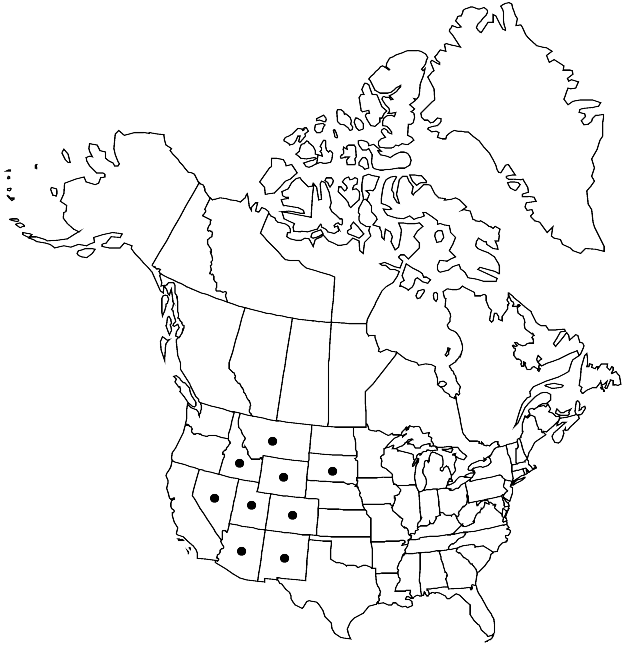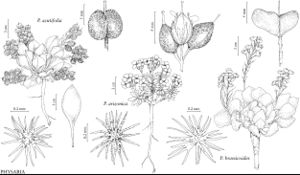Difference between revisions of "Physaria acutifolia"
Bull. Torrey Bot. Club 28: 279. 1901.
FNA>Volume Importer |
imported>Volume Importer |
||
| (3 intermediate revisions by 2 users not shown) | |||
| Line 12: | Line 12: | ||
|name=Physaria acutifolia var. stylosa | |name=Physaria acutifolia var. stylosa | ||
|authority=(Rollins) S. L. Welsh | |authority=(Rollins) S. L. Welsh | ||
| + | |rank=variety | ||
}} {{Treatment/ID/Synonym | }} {{Treatment/ID/Synonym | ||
|name=Physaria australis | |name=Physaria australis | ||
|authority=(Hooker) A. Gray | |authority=(Hooker) A. Gray | ||
| + | |rank=species | ||
}} {{Treatment/ID/Synonym | }} {{Treatment/ID/Synonym | ||
|name=Physaria didymocarpa var. australis | |name=Physaria didymocarpa var. australis | ||
|authority=Payson | |authority=Payson | ||
| + | |rank=variety | ||
}} {{Treatment/ID/Synonym | }} {{Treatment/ID/Synonym | ||
|name=Physaria stylosa | |name=Physaria stylosa | ||
| − | |authority= | + | |authority= |
| + | |rank=species | ||
}} | }} | ||
|hierarchy=Brassicaceae;Brassicaceae tribe Physarieae;Physaria;Physaria acutifolia | |hierarchy=Brassicaceae;Brassicaceae tribe Physarieae;Physaria;Physaria acutifolia | ||
| Line 36: | Line 40: | ||
|elevation=1500-3500 m | |elevation=1500-3500 m | ||
|distribution=Ariz.;Colo.;Idaho;Mont.;Nev.;N.Mex.;S.Dak.;Utah;Wyo. | |distribution=Ariz.;Colo.;Idaho;Mont.;Nev.;N.Mex.;S.Dak.;Utah;Wyo. | ||
| − | |discussion=<p><i>Physaria acutifolia</i> tends to be somewhat dwarfed, with a branched caudex and especially long styles (< | + | |discussion=<p><i>Physaria acutifolia</i> tends to be somewhat dwarfed, with a branched caudex and especially long styles (<i></i>var.<i> stylosa</i>), where it grows at high elevations, especially at the western end of the Uinta Mountains in Utah. Intermediates form an uninterrupted cline and no infraspecific taxa are here recognized. In R. C. Rollins (1939), the discussion of <i>P. acutifolia</i> actually pertains to <i>P. rollinsii</i>. The discussion of <i>P. australis</i> pertains to what is now known as <i>P. acutifolia</i>. The plants are usually found in open soil patches, rarely into the subalpine or alpine tundra.</p> |
|tables= | |tables= | ||
|references= | |references= | ||
| Line 45: | Line 49: | ||
-->{{#Taxon: | -->{{#Taxon: | ||
name=Physaria acutifolia | name=Physaria acutifolia | ||
| − | |||
|authority=Rydberg | |authority=Rydberg | ||
|rank=species | |rank=species | ||
| Line 60: | Line 63: | ||
|publication year=1901 | |publication year=1901 | ||
|special status= | |special status= | ||
| − | |source xml=https:// | + | |source xml=https://bitbucket.org/aafc-mbb/fna-data-curation/src/2e0870ddd59836b60bcf96646a41e87ea5a5943a/coarse_grained_fna_xml/V7/V7_1012.xml |
|tribe=Brassicaceae tribe Physarieae | |tribe=Brassicaceae tribe Physarieae | ||
|genus=Physaria | |genus=Physaria | ||
Latest revision as of 22:29, 5 November 2020
Perennials; caudex branched, (sometimes forming a thick crown, cespitose); (silvery) pubescent throughout, trichomes several-rayed, rays furcate, (moderately tuberculate, rays weakly so). Stems several from base, usually somewhat decumbent, (unbranched), (0.4–)0.5–2 dm. Basal leaves: (petiole slender, often narrowly winged); blade obovate to orbicular or rhombic-orbicular, 2–9 cm, (base abruptly narrowed to petiole), margins usually entire, rarely with few scattered teeth, (apex rounded or obtuse, sometimes with apical mucro). Cauline leaves: blade spatulate to oblanceolate, 1–3 cm, margins entire, (apex usually obtuse). Racemes loose, (elongated in fruit). Fruiting pedicels (divaricate, slightly sigmoid or nearly straight), 6–12 mm. Flowers: sepals linear-oblong, 4–7.5 mm; petals spatulate, 6–11 mm. Fruits (erect), didymous, suborbicular, inflated, (4–)6–15 × (4–)8–20 mm, (papery, basal and apical sinuses similar, basal rarely shallower, apical deep, narrow and closed or nearly so); valves retaining seeds after dehiscence, pubescent, trichomes appressed; replum oblong, constricted, 2–3.5 mm, narrower than fruit, apex obtuse; ovules (2 or) 4 per ovary; style 4–6(–9) mm. Seeds (dark brown), flattened, (2–3 mm). 2n = 10, 16, 24.
Phenology: Flowering May–Jun(-Jul).
Habitat: Hillsides, roadcuts, sagebrush, pinyon-juniper, Gambel oak, ponderosa pine communities
Elevation: 1500-3500 m
Distribution

Ariz., Colo., Idaho, Mont., Nev., N.Mex., S.Dak., Utah, Wyo.
Discussion
Physaria acutifolia tends to be somewhat dwarfed, with a branched caudex and especially long styles (var. stylosa), where it grows at high elevations, especially at the western end of the Uinta Mountains in Utah. Intermediates form an uninterrupted cline and no infraspecific taxa are here recognized. In R. C. Rollins (1939), the discussion of P. acutifolia actually pertains to P. rollinsii. The discussion of P. australis pertains to what is now known as P. acutifolia. The plants are usually found in open soil patches, rarely into the subalpine or alpine tundra.
Selected References
None.
